Subtotal: $
Checkout
Will Tabasco Survive Big Oil?
Mexico’s Pemex might finally meet its match in rising seas. But will the people of Tabasco’s coastline survive the industry’s ravages?
By Diana Amador
October 20, 2023
Tabasco feels ancient. There is an air of prehistory in its thick vegetation, lush fruit trees, and caimans that open their jaws on the shores of the lagoons. But under its green mantle lies a promise of abundance which has betrayed its residents time and again. In the name of economic development, a multifaceted disaster has been born. In January 2023, we visited Tabasco’s coastal area to interview locals, from fishermen to professionals, seeking to understand the human cost of poor environmental stewardship.
This Mexican state located over four hundred miles southeast of Mexico City has often been at the center of political disputes. It was key to the rise of Andrés Manuel López Obrador, popularly known as AMLO, who became president of Mexico in 2018. Geographically, it is the delta of two great rivers which bifurcate and converge throughout the territory. The plain is so close to sea level that, according to Climate Central, by 2050 a quarter of Tabasco will be underwater. And some 92,500 people will lose their homes.
Pemex, Mexico’s national oil company, operates in fourteen of Tabasco’s seventeen municipalities. Its facilities occupy twelve thousand hectares, and it has more than five thousand miles of pipelines under land and sea – although little is known about their exact location. Each year, it attracts over $150 million in foreign investment, and seventy and a half million dollars of its profits are transferred to the government. Those who live near this monster know little about what goes on inside, but they do know what it leaves in its wake. “There is a myth that oil has given us our schools, roads, and hospitals, but little of that supposed development is in Tabasco. Here we just see the impacts of pollution and climate change,” says Pablo Montaño, director of the organization Conexiones Climáticas.
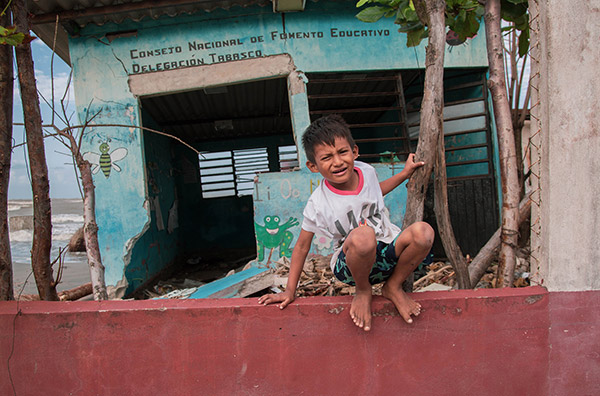
A child in front of the remains of the National Council for the Promotion of Education, El Bosque, Tabasco, Mexico. All photographs by Souleyman Messalti date from January 2023. Used by permission.
The Encroaching Sea
The Andrés García barrier island is located in the municipality of Paraíso, between the Gulf of Mexico and the Mecoacán Lagoon. Here Pemex is the watchman that never sleeps, lurking over the island’s 318 residents in the form of Dos Bocas, a port and refinery. Three suns never set: the refinery’s chimneys. As we approach, the stench of burning fuel reaches us first, and then the flaming chimneys appear. As we cross the lagoon in a boat, the distant murmur grows louder.
Jazmín Córdova, age twenty-five, meets us with Alison, her five-year-old daughter. As we disembark, we notice a concrete path that once ran along much of the island, but now remains in most places as only bits and pieces. This sidewalk, Ms. Córdova says, is only five years old. It is true that Tabasco has a high annual rainfall, holds 30 percent of the country’s fresh water, and has sandy soil. But something else has accelerated a crisis that now seems inevitable: the state will be devoured by the sea. About six years ago, the lagoon’s water was some thirty to fifty feet beyond where it is today. And on the other side of this barrier island 1.7 miles long and nine hundred yards wide, the sea has claimed at least 650 yards.
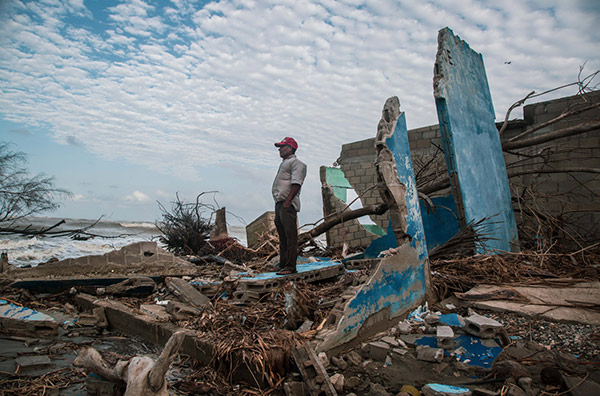
Nereo Ponce stands in the ruins of El Bosque’s church.
Andrés García’s residents can name the moment they were condemned: in the eighties when Pemex extended its tentacles under them. The company razed the village of Torno Largo to build Dos Bocas. They built breakwaters all around the island to allow the docks to operate, but these changed the ocean currents.
Dr. Juan Carlos Pérez Jiménez, a specialist in Marine Ecology at El Colegio de La Frontera Sur (Ecosur), knows that any structure built in the sea changes natural currents: “Strong currents from the Caribbean enter the Gulf and form a circular stream that is running beside Tabasco and Campeche,” he explains. “The natural circulation carries away the sediments from Tabasco’s many rivers. This causes erosion in some places, and new deposits in others. So if you build even a very simple structure, it always causes problems in the long term.” Since 2016, Tabasco’s coastline has receded by about twenty feet annually. “Coastal erosion is natural, but it doesn’t usually happen at the speed we are seeing,” he says.
According to Climate Central, by 2050 a quarter of Tabasco will be underwater, and some 92,500 people will lose their homes.
The threat of rising waves is not the only problem. The fields here used to be full of a whole range of tropical fruit, but today the land is infertile. Most residents used to be fishermen: Porfirio Córdova, Jazmín Córdova’s father, built his house with the money he made from the sea. There were good seasons when there was never a lack of food on the table. Shrimp was plentiful, there was excess fruit to sell, and tourists didn’t want to leave the bucolic island. Until one day it wasn’t that way anymore. The fish were scarcer, and the fishermen had to venture farther out to catch them. Many times, the nets they drew in were loaded with something heavy that looked like mud but, when they touched it, left them with itchy welts. They never knew for sure what it was.
With four children to feed, Porfirio had to look for a job with one of the oil companies. For the past eighteen years he has cleaned ship holds which are notoriously dark, low on oxygen, and thick with chemicals. Since he accepted the job, he has been a “temporary employee,” without social security or benefits. The twenty-five dollars he earned today will be used to buy bread and water for his family.
Water is also scarce on this island. There is no water system, and rain water is not an option.
“It rains a lot here, but it’s not normal rain,” says Porfirio. “It stains the flowers and fruit black with ash.” Sometimes the residents wake up early in the morning to an intense smell of gasoline and see a curtain of smoke billowing from the oil facilities. “Your throat starts to itch and your nose burns; you want to cough and you can’t. And wherever it goes, it leaves everything black,” says the fisherman.
An Island Where the Sun Never Sets
At least three times in the last twenty years, the residents of Andrés García have gone through the oil company’s labyrinth of bureaucracy to make a claim. But after a so-called “environmental study,” each claim was rejected. There was no evidence, said Pemex, that the incandescent flames that illuminate the island were to blame. Porfirio Córdova and other fishermen staged protests, once in front of Dos Bocas, once on the highway. Nothing changed.
Today is a quiet day: the wells are not being vented. Some days, the murmur from the chimneys grows to a roar of gas and fire. The people can’t talk, can’t sleep, can’t get rid of that intense buzzing that has made at least seven people deaf. Jazmín, who studied engineering thanks to a scholarship from Chevron, explains that the system needs periodic depressurization. She shows us a video of the experience: The flare becomes the mouth of an attacking dragon, and the hands of the person recording the video tremble. The island shudders from the roar, which splinters glass and cracks walls and ceilings. As the clip ends, we look up to see Porfirio carrying bags of cement and rebar from a boat. He will repair his house, although the cracks he covers today will reappear in a week.
Every night, this island plunges into a twelve-hour dawn. Like the other fifty-nine children who live here, little Alison knows neither darkness nor the calm of a peaceful sleep. She tells us she covers her head with a pillow at night. Sometimes she dreams a cloud of mosquitos is buzzing around her head.
As if that weren’t enough, there are other menaces. Polycyclic aromatic hydrocarbons (PAHs) are contaminants produced by oil extraction. According to Teresa Gamboa Rodríguez, a scientist, constant exposure to PAHs causes genetic damage, increasing the chance of cancer in future generations. Gamboa Rodríguez studied the increase in acute childhood lymphoblastic leukemia in Tabasco. “All the study groups in areas with high oil activity presented moderate to high levels of genotoxic damage,” the paper says. “It can be concluded that fossil fuels have been responsible, in recent decades, for the increase in cancer cases [in Tabasco].” In 2015, the State Human Rights Committee repeated the study in this area alone and found that 15 percent of the children had genetic damage.
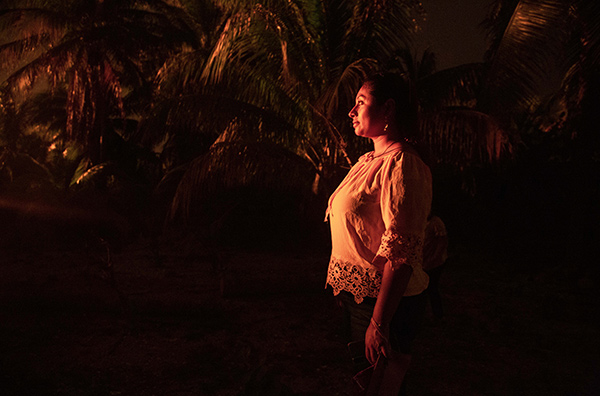
Jazmín Córdoba stands in the light of Dos Bocas refinery’s flares.
Porfirio doesn’t need to read the studies: he has seen his neighbors and relatives fall ill. His own father died of cancer. “A lot of people have gotten it, in the throat, the lungs, the skin. Some people start getting spots like I have here,” he says, pointing to a fleshy lump on his forehead.
“How do you know Pemex is the cause?” I ask Jazmín.
“When people started getting sick, the doctors asked us where we lived, if we were exposed to smoke or pollutants. We also know that whenever they vent the chimneys, the whole island feels ill.”
Here, cancer is usually a death sentence. There are no medical services nearby and the specialty hospital is over fifty kilometers away. With no cars, no public transportation, no insurance, and no money, chemotherapy is unthinkable. Ms. Córdova recalls at least fifteen people who were diagnosed in recent years. Only one has beat the odds: her fifteen-year-old cousin Luis Felipe Mendoza. The community requested help from the Banco de Tapitas foundation, which covers the cost of treatments by selling plastic bottle caps. They collected three thousand bottle caps for each round of chemotherapy. About thirty times, over the course of seven years.
Although Jazmín has an engineering degree, she has not been able to get a job since she graduated. “They say Pemex brings employment, but it doesn’t. You need to know someone in the union to get in, and if not, you stay like me, just waiting for the sea to wash over me.”
Four hundred meters away, the Dos Bocas refinery is growing. More than eight billion dollars are being poured into facilities that, like the rest of the coast, are always on the verge of flooding. Images from January 2022 show parts of the unfinished construction already covered by water.
Battling a Giant
The road to the town of Andrés Sánchez Magallanes in the municipality of Cárdenas is a journey through otherworldly landscapes. The temperature is around 85 degrees at seven in the morning. The countryside is covered by a humid fog. But where there should be a thick jungle there are open fields, cleared for livestock. Zebu have been imported since 1925 because the local cattle couldn’t handle the climate. They eat in silence with herons perched on their backs and horns. They take a few steps and their hooves sink into what has become a swamp.
“This plague came with Pemex,” says doctor Antonio Ramos. “Now the sea is taking everything away.” Ramos is a tall man, about seventy-five years old, who speaks with the grandiloquence of a revolutionary. In his office in the Benito Juárez villa, the blue walls are covered with images of the leaders who inspire him: Pancho Villa, Emiliano Zapata, Che Guevara, and López Obrador, who he has followed since 1996. At that time, thousands of fishermen led by AMLO occupied sixty oil wells. There were violent arrests. Like now, when AMLO is president, nothing changed.
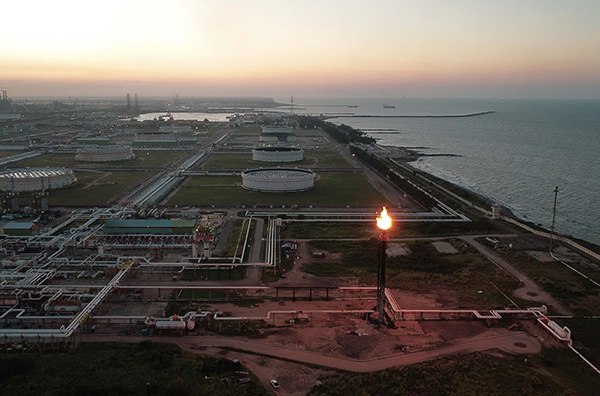
Dos Bocas refinery
Antonio began his battle against the giant in the seventies when a group of shareholders whose commonly held land was affected by the oil company staged protests. Their efforts intensified when Pemex opened canals between the sea and the lagoons. According to Juan Carlos Pérez Jiménez of Ecosur, this condemned the ecosystem: “They filled the lagoons with salt. Many species cannot survive. They just disappear, and with them go the fishermen.” Today, the village is a ghost town.
The doctor shows us around the disaster zone. His wife, Georgina, leads him by the hand and tells him what she sees: the road that is collapsing, the plot of land that is still flooded. They met thirty years ago, when she started working as his receptionist. Now she has become his eyes, his infallible compass. They have walked together in good times: when Antonio traveled through the shanty towns to attend births, when he was the town’s liaison with the Tabasco authorities. They have also seen bad times: when childhood leukemia cases increased, when hectares of crops were lost, when they organized with other communities to sue Pemex, when they protested at the oil installations in 2008, when the police arrested almost everyone, when he hid in the jungle until he got a lawyer, when Pemex rejected their claims, when their companions in the struggle began to die. When it seemed he was left alone.
“Pemex is a death sentence for every town it touches,” says Antonio. “Imagine a town that has everything: the sea, heat, vegetation; its people have everything they need. Then one day a company arrives and stains it black, destroying every living thing in its path. And nobody cares,” he says with the forcefulness of someone who has incited the masses. Today, it’s impossible to make a living from fishing, farming, or tourism in Andrés Sánchez Magellanes. Neither is there work at Pemex, which has extracted everything it can and is pulling out. Of the 5,518 people living here, 71 percent are indigent.
Remnants of a Fishing Village
The Andrés Sánchez Magallanes coastal highway runs along a string of barrier islands all the way to Paraíso. It is winding and fractured and the asphalt, once the main thoroughfare between oil towns, has been eaten away by the waves. According to Ecosur, this area loses about sixteen feet each year to coastal erosion, but many places have seen even more according to Antonio Ramos and the others who still live near the ruined road.
A young man hails us from a hammock, and a scowling woman stop us with a machete in hand. The road has disappeared, so they have opened a way through the palms. Using it costs us fifty cents. And thus we arrive at Boca de Panteones in the municipality of El Alacrán, a hostile place that was once a symbol of development and abundance. There is a long concrete bridge, empty save our car. Beneath, there is nothing but sand.
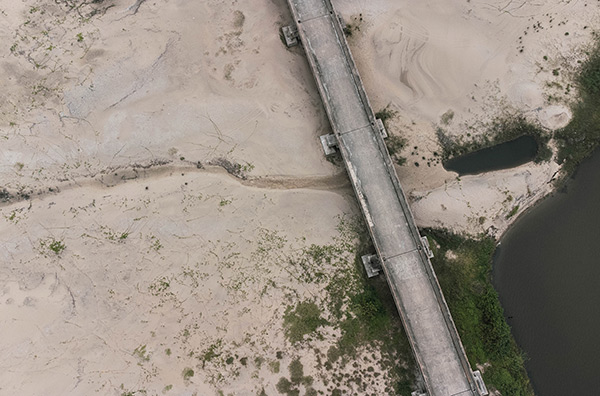
This bridge was built for Pemex workers. Most of the highway is now inaccessible to traffic, due to the changing coastline.
The local phrase “when all this began” refers to the arrival of Pemex in the 1960s as well as the end of a happier time when they fished where now there is a bridge but no water, when palm trees were loaded with coconuts, when there was an active school and church. The sea and lagoons gently mix their waters in many places, but opening deep canals for industry brings disaster. The sea’s violent entrance overflowed the Machona lagoon, flooding the surrounding land. Salt and oil residues poured in, and the town died. Along some thirty-two miles of coastline, at least 160 canals now join the lagoons to meet the sea. “Since then, the national priority has been oil: whatever makes us the most money,” says Patricia Moreno, a researcher at the Institute of Ecology.
Like the other fifty-nine children who live here, little Alison knows neither darkness nor the calm of a peaceful sleep. She tells us she covers her head with a pillow at night.
In Boca de Panteones, the sea has even devoured the cemetery. “It had been raining for days and the sea was rough. We heard pounding, cracking, the air was screaming. We saw the waves tear away the earth, the coffins floating. Everything was carried away … even the dead,” says a local man, Renán Sánchez. The house where the fifty-nine-year-old lives with his wife, three daughters, and five grandchildren no longer has doors or windows. “There is no point, the sea will take everything,” he says. Outside, he has built a one-meter-high barrier of oyster shells to keep the water from his house. On the beach you can see the remnants of a sandbag wall which was buried in sand years ago, black with thick oil residue.
Dr. Ramos tours us around this village where, in 2013, he gathered testimonies and evidence to file a claim against Pemex with The Mexican Center for Environmental Law (CEMDA). In the decade since, most of his co-claimants have died. “That’s why we can’t give up,” he says. In Mexico, justice is a cumbersome giant. But in Tabasco it has leaden feet. “First they told us there was no pollution. Then that there was, but it wasn’t Pemex’s responsibility,” says Xavier Martinez, a lawyer with CEMDA. “That’s how they’ve stalled us for ten years.” How did Pemex prove there was no pollution? I ask. “In Tabasco, Pemex rules,” explains Martinez. “Almost all the laboratories and specialists are Pemex’s suppliers and contractors. Nobody wants to lose business.”
Noah’s Ark
El Bosque, a community in the municipality of Centla, is perhaps the most striking example of coastal erosion. For some time, its inhabitants have watched their town grow smaller by the day, but in 2019 the disaster accelerated. Ecosur researchers found that forty yards of land were lost in just four months; today, the island is only 210 yards wide.
Victoria Coto knew the sea would take her house. An evangelical pastor told her so seven years ago, in this very church. She imagined a hurricane would come through, but nothing prepared her for this. She and her family now live in rooms owned by the church, since the daughter she had moved in with lost her home in the devastating storm that chased residents from their homes on Christmas Eve last year. “When I saw the sea wash everything away, I thought, ‘Thank you, God, for letting me live here for more than twenty-five years,’” she says.
El Bosque is a disaster zone, the ruins of a town. The roaring sea has covered almost everything with salt and sand. This fishing village owes much to its waters, but has already paid back more than its share. Victoria points out where her first house was, an invisible spot in the middle of the sea. “When the tide is very low, you can see the house,” she says.
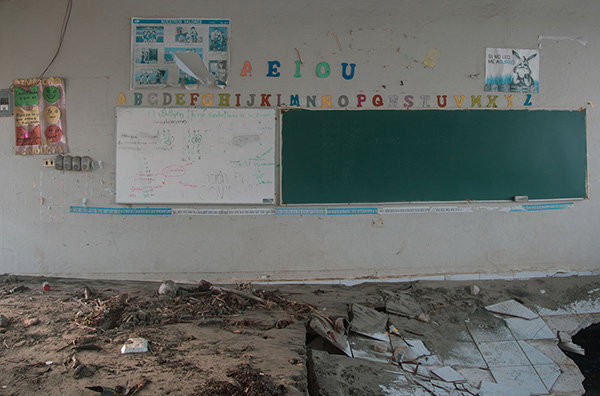
Remains of El Bosque’s elementary school. The teacher now conducts classes in the children's homes.
She knows about global warming: she saw it on television. “They showed images of flooded villages, and that’s when I knew the pastor was right. Sometimes we don’t understand God’s will, but we have to accept it. I think the town of Paraíso is next, and then Veracruz. We are neither the first nor the last; we are the ones who will not be saved.”
Another church, now a mutilated structure, stood on the main street. “Noah’s ark” is written on the broken wall that remains standing. Farther on is the school where ten children once studied. Inside, it is frozen in time. The blackboard is covered with unsolved math problems, books have rotted on the shelves, toys and lunch boxes float on the flooded floor. In March 2019, President López Obrador gave a speech here on the five hundredth anniversary of the battle of Centla, the first confrontation between native peoples and Spanish conquistadors. He said he would send letters to the king of Spain and Pope Francis, inviting them to apologize for the atrocities against indigenous peoples. He also promised to boost the local economy through new oil projects. The villagers desperately tried to tell him what was happening there. His security team did not allow it.
Just days after our visit, new storms were forecast. Everyone was preparing for the worst. “If it’s Christmas again, I’ll let you know,” Jazmín Córdova says. Her family takes down their palm roofs so the wind won’t carry them away. I call Roque Martinez, who is finishing a sandbag barrier. The sea is getting closer. There are no words of encouragement for someone who could lose everything. “Take care of yourself,” I tell him helplessly. In the background, I can hear the screaming wind, the roaring sea, the murmuring palm trees. “Nobody takes care of us here,” he replies. “If I don’t answer on Thursday, it’s because the sea has taken us too.”
This article and the accompanying images first appeared in Gatopardo No. 224, January-April 2023. Translated from the Spanish and edited for length by Coretta Thomson. Used by permission.
About the photographer: Souleyman Messalti is a French-Algerian documentary filmmaker who specializes in investigative journalism and conflict reporting. He holds a masters in cinemetography and has covered topics such as the acid attacks in India, disappearances in Mexico, and the democratic movement in Hong Kong. His work has appeared in the New York Times,Vice, the BBC, and National Geographic.
Already a subscriber? Sign in
Try 3 months of unlimited access. Start your FREE TRIAL today. Cancel anytime.







Michael Nacrelli
But hey, as long as AMLO and PDR champion LGBT issues and the liberalization of abortion laws, they're good progressives, right?